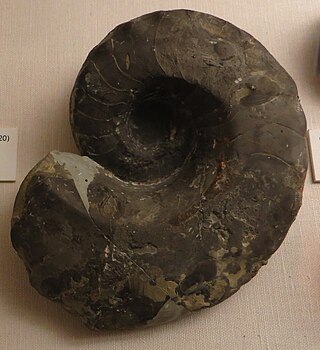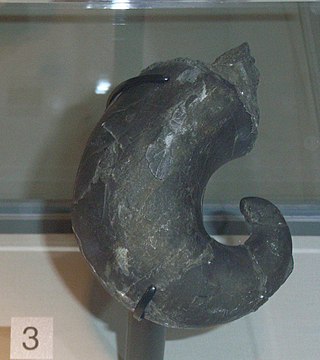
Nautiloids are a group of marine cephalopods (Mollusca) which originated in the Late Cambrian and are represented today by the living Nautilus and Allonautilus. Fossil nautiloids are diverse and speciose, with over 2,500 recorded species. They flourished during the early Paleozoic era, when they constituted the main predatory animals. Early in their evolution, nautiloids developed an extraordinary diversity of shell shapes, including coiled morphologies and giant straight-shelled forms (orthocones). Only a handful of rare coiled species, the nautiluses, survive to the present day.
Uranoceras is a barrandeocerid genus from the Middle Silurian belonging to the family Uranoceratidae, characterized by its loosely coiled, gyroconic shell of 1.5 to 2 subquadrate whorls.
Strophiceras is an extinct genus of cephalopods from the Order Nautilida, which includes, in a separate family, Nautilus and Allonautilus.
Homaloceras is an extinct nautiloid cephalopod from the Middle Devonian with a strongly curved shell, included in the nautilid family Centroceratidae.
Permoceras, the sole member of the family Permoceratidae, is a genus of coiled nautiloids with a smooth, compressed involute shell, whorls higher than wide, earlier whorls hidden from view. The venter is rounded as are the ventral and umbilical shoulders, the flanks flattened. The siphuncle is ventrally subcentral. The suture, which is most characteristic, has a deep, narrow pointed ventral lobe and large, asymmetrical pointed lobes on either side.
Endolobus is an extinct genus from the nautiloid order, Nautilida. Nautiloids are a subclass of shelled cephalopods that were once diverse and numerous but are now represented by only a handful of species, including Nautilus. Endolubus is included in the family Koninckioceratidae which is part of the superfamily Tainoceratoidea.
Permonautilus is an extinct genus of nautilids from the Upper Permian of Russia, named and described by Kruglov in 1933. Permonautilus is an involute, globular, spinose member of the Lirocertidae which are included in the Clydonautilaceae. Whorl sections are broad, with a rounded venter. The umbilicus in the middle of the shell is deep, from which spine-like processes extend laterally in the mature portion near the aperture. The siphuncle in Permonautilus is subcentral, the suture, slightly sinuous.
Tetrapleuroceras is an extinct prehistoric nautiloid from the Lower Permian of the Urals in Russia. Nautilids are a type of nautiloid, a subclass of shelled cephalopods that were once diverse and numerous but now only represented by Nautilus and Allonautilus
Tithonoceras is a genus of nautiloid cephalopod from the Upper Jurassic found in the Crimea, belonging to the nautilacean family Paracenoceratidae.

Titanoceras is an extinct genus in the nautiloid order Nautilida from the Pennsylvanian and Lower Permian of North America and Western Australia.
Valhallites is an extinct genus in the nautiloid order Nautilida which includes the living Nautilus found in the tropical western Pacifiic. Valhalites belongs to the Koninckioceratidae, a family in the Tainoceratoidea, a nautilid superfamily.
Heminautilus is an extinct genus of nautiloids from the nautilacean family Cenoceratidae that lived during the Early Cretaceous. Fossils of Heminautilus have been registered in rocks of Barremian and Aptian age. Nautiloids are a subclass of shelled cephalopods that were once diverse and numerous but are now represented by only a handful of species.
Stroboceras is an extinct genus of nautiloids named by Hyatt in 1884 that's included in the nautilid family Trigonoceratidae; the group that have rise to the Nautilidae which includes the living Nautilus.
Stearoceras is an extinct genus of prehistoric nautiloids from the Lower Pennsylvanian - Lower Permian with a fair worldwide distribution.(Kümmel 1964)
Triboloceras is the name given to an extinct nautiloid genus from the Lower Carboniferous (Mississippian), included in the nautilid family Trigonoceratidae characterized by an evolute shell bearing longitudinal ribs, with whorls in contact except in the early and very latest growth stages. Chambers are short, sutures tend for form ventral and in some cases dorsal and lateral lobes. The siphuncle is small, tubular, and subcentral.
Trigonoceras is an extinct genus of prehistoric nautiloids from the nautilid family Trigonoceratidae that lived during the Early Carboniferous in what is now western Europe.

Germanonautilus is a cephalopod genus included in the nautilid family Tainoceratidae, found widespread in the Triassic of North America, Europe, Asia, and north Africa. The shell is a moderately involute nautilicone ; whorl section subquadrate to trapezoidal, widest across the umbilical shoulders, flanks flattened and ventrally convergent, venter flat and wide, dorsum narrowly and deeply impressed. The suture is with broad and deep lateral lobes and a shallow ventral lobe. The siphuncle is central and nummuloidal, composed of expanded segments that give a beaded appearance.
Diademoceras is a genus of nautiloid cephalopods from the middle Devonian of North America, named by Rousseau Flower in 1945. The genus is a tainoceratacean included in the nautilid family Rutoceratidae.

Domatoceras is a nautiloid genus and member of the Grypoceratidae from the Pennsylvanian and Permian with a wide spread distribution.

Aipoceras is a genus of loosely coiled aipoceratid nautiloids with laterally compressed whorls; shells expanding moderately to fairly rapidly with a tendency to uncoil at maturity. Juvenile forms are somewhat cyrtoconic. The apical end forms a hook. Aipoceras has been found in Lower Mississippian strata in the U.S.




